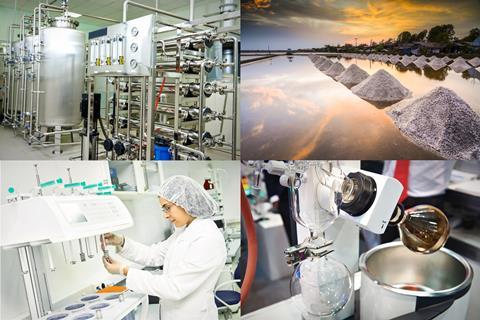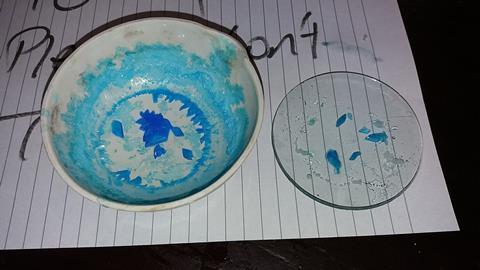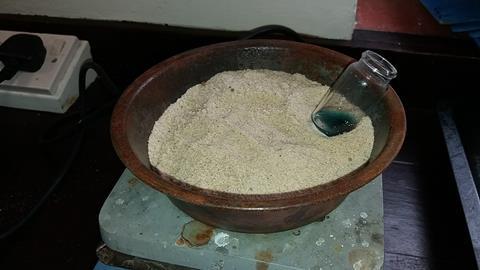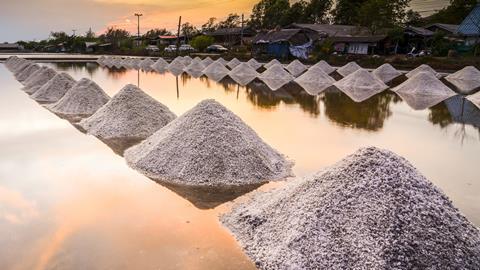David Paterson discusses ideas for enhancing practical work on separating mixtures by filtration, evaporation and crystallisation
The physical processes of separating mixtures by filtration, evaporation and crystallisation are key to many industrial and research purposes. For example, water purification, edible salt production and pharmaceutical formulation require aspects of these techniques. Research chemists preparing new substances will frequently use these processes. Substances require purification to allow for further synthetic steps and for structural analysis.

Underlying principles
The science of separating substances is based on the principles of purity, physical properties and solutions. For example, chromatography is a separation process based on solubility1 and distillation is based on boiling point.2 This article looks at separation by particle size (filtration) and removal of volatile solvents (evaporation and crystallisation).
The science of separating substances is based on the principles of purity, physical properties and solutions. For example, chromatography is a separation process based on solubility1 and distillation is based on boiling point.2 This article looks at separation by particle size (filtration) and removal of volatile solvents (evaporation and crystallisation).
Underlying all separation techniques are the concepts of purity and the difference between mixtures and compounds. You can discuss purity using everyday drinks as a context. Students could analyse the labels of bottled water or juices that claim to be ‘100% pure’ to show they contain various substances. Among other components, mineral waters contain varying levels of dissolved salts, and orange juices contain sugars, protein and vitamin C.

Practical activities to help students distinguish mixtures from compounds include the classic iron sulfide synthesis reaction.3 The reaction of aluminium with iodine also provides a memorable demonstration.4 Students could repeat the simple separations of mixtures they have carried out at primary or 11–14 level. For example, separating iron filings from sand5 or breakfast cereal.6
Practical activities to help students distinguish mixtures from compounds include the classic iron sulfide synthesis reaction.3 The reaction of aluminium with iodine also provides a memorable demonstration.4 Students could repeat the simple separations of mixtures they have carried out at primary or 11–14 level. For example, separating iron filings from sand5 or breakfast cereal.6
You can easily demonstrate the importance of particle sizes by sieving a mixture of rice and caster sugar. Or, show the volatility of substances by using a few drops of propanone on a watch glass in different environments.7
You can easily demonstrate the importance of particle sizes by sieving a mixture of rice and caster sugar. Or, show the volatility of substances by using a few drops of propanone on a watch glass in different environments.7
Use the context of the formation of saturated solutions of ammonium chloride to discuss the concepts of solution and saturation.8 Try this activity both qualitatively and quantitatively, introducing concentration and solubility calculations in later years. The Chemical misconceptions resources9 cover the differences between elements, compounds and mixtures.
Use the context of the formation of saturated solutions of ammonium chloride to discuss the concepts of solution and saturation.8 Try this activity both qualitatively and quantitatively, introducing concentration and solubility calculations in later years. The Chemical misconceptions resources9 cover the differences between elements, compounds and mixtures.
A relevant context to engage students, and link to social and economic aspects of chemistry, is the separation of metals ores. Rocks are mixtures of different minerals, and must be separated to concentrate and eventually purify the desired metal. Physical processes such as crushing, sifting and flotation separate the components.10 The recycling industry uses similar processes to separate metals, glasses and plastics in household waste,11 and when recycling cars.
A relevant context to engage students, and link to social and economic aspects of chemistry, is the separation of metals ores. Rocks are mixtures of different minerals, and must be separated to concentrate and eventually purify the desired metal. Physical processes such as crushing, sifting and flotation separate the components.10 The recycling industry uses similar processes to separate metals, glasses and plastics in household waste,11 and when recycling cars.
Techniques through the curriculum
Students learn the techniques of evaporation, filtering and crystallisation from primary school through to post-16 education.
Students learn the techniques of evaporation, filtering and crystallisation from primary school through to post-16 education (see table). Download a detailed table of links to the national curriculum and exam specifications from the Education in Chemistry website: rsc.li/EiC418sep2.
| Ages 5–7 (Key Stage 1) | Ages 7–11 (Key Stage 2) | Ages 11–16 (Key Stages 3 and 4) | Ages 16–18 (Key Stage 5) |
|---|---|---|---|
|
Separation with sieves Formation of limescale (dissolved solids) |
Rock cycle – formation of sedimentary rocks Water cycle – filtering of water through rocks |
Filtering Evaporating Crystallising |
Recrystallising |

Specification links
Download a table of links to exam specifications and the English national curriculum (MS Word or pdf)
Evaporation
Evaporation requires heat (or air movement above the sample) to drive off a volatile solvent. If the substance is a solid mixed in a solvent, begin by filtering (or decanting). If the substance is dissolved in a solvent, then use crystallisation.
There are various techniques for heating a substance. For example, direct heating with a Bunsen burner or a sand bath, or by placing an evaporating basin over a beaker of heated water. Students could discuss and evaluate the different methods. For example, direct heating is quicker, but can superheat the solution, potentially degrading the solute and leading to spitting of the solid. You can make links to the difference between distillation via direct heating and steam distillation, and the use of the latter in separating fragile components.2
There are various techniques for heating a substance. For example, direct heating with a Bunsen burner or a sand bath, or by placing an evaporating basin over a beaker of heated water. Students could discuss and evaluate the different methods. For example, direct heating is quicker, but can superheat the solution, potentially degrading the solute and leading to spitting of the solid. You can make links to the difference between distillation via direct heating and steam distillation, and the use of the latter in separating fragile components.2
Students could annotate diagrams of the different methods to consolidate their understanding and help them learn the names and diagrams of the various laboratory apparatus.
Download a set of labelled apparatus diagrams and a worksheet without labels for use in your classroom from the Education in Chemistry website: rsc.li/EiC418sep2.
Having a set of questions ready to ask can help focus students on the purpose and practicalities of the techniques (see table 1).
Having a set of questions ready to ask can help focus students on the purpose and practicalities of the techniques.
| Technique | Possible questions |
|---|---|
|
Evaporation |
What observations tell you the evaporation is complete? What is the best heat source for this mixture? How does this evaporation fit into a larger separation procedure (eg filtration/crystallisation)? |
|
Filtration |
Why is the solid residue retained on the filter paper? How successful has the filtration been (how clear is the filtrate)? What is the advantage of a fluted filter paper? Is the residue fully purified once all the filtrate has passed through the filter paper? |
|
Crystallisation |
Where and why do crystals first form in the solution? What factors affect the size and quality of the crystals formed? Have solvent molecules formed part of the crystal structure? |
Filtration
Filtration requires various pieces of glassware, which can lead to student confusion about what needs placing where, and what is poured where and when. It is worth re-demonstrating and explicitly naming the apparatus to reinforce this important knowledge. Most students will be able to carry out filtration without further guidance, although there is a range of common issues (see table).
Filtration requires various pieces of glassware, which can lead to student confusion about what needs placing where, and what is poured where and when. It is worth re-demonstrating and explicitly naming the apparatus to reinforce this important knowledge. Most students will be able to carry out filtration without further guidance, although there is a range of common issues.
| Issue | Suggested solution |
|---|---|
|
Slow filtering |
Use fluted filter paper Use filtration under reduced pressure Use a different grade filter paper (coarser) |
|
Slow filtering (due to poor reduced pressure) |
Check water pressure – use faster taps if available Check efficiency of pumps – check for leaks/service the pumps |
|
Solid in filtrate – due to a hole in the filter paper (usually the student has poked the paper with a glass rod), mixture poured in too quickly (over-topped the filter paper), or filter paper not adhered to base of Buchner funnel
|
Use a different grade filter paper (finer) Pre-wet the paper with solvent to adhere it to the Buchner funnel |
Crystallisation
Crystallisation occurs when the solution solvent evaporates, and the concentration of the solute reaches saturation point. At this stage, the solute begins to precipitate out of solution. Under the right conditions, generally slow evaporation and a clear solution, the solute will crystallise. You can easily demonstrate the principles of crystallisation with saturated solutions of sodium acetate.12 Teachers commonly use this activity to model the freezing process, and it helps tackle misconceptions around the energetics of freezing, particularly the exothermic nature of freezing (bonds being formed). A similar activity suitable for a student practical is freezing super-cooled sodium thiosulfate.13
Crystallisation occurs when the solution solvent evaporates, and the concentration of the solute reaches saturation point. At this stage, the solute begins to precipitate out of solution. Under the right conditions, generally slow evaporation and a clear solution, the solute will crystallise. You can easily demonstrate the principles of crystallisation with saturated solutions of sodium acetate.12 Teachers commonly use this activity to model the freezing process, and it helps tackle misconceptions around the energetics of freezing, particularly the exothermic nature of freezing (bonds being formed). A similar activity suitable for a student practical is freezing super-cooled sodium thiosulfate.13
Recrystallisation is a key practical skill required at A-level. Benzoic acid is a useful substance to demonstrate and practise the technique. Benzoic acid will dissolve in hot water and crystallise when the water cools, potentially reducing the need to carry out recrystallisation using organic solvents.14 This can be particularly useful if you have limited access to fumehoods.
Recrystallisation is a key practical skill required at A-level. Benzoic acid is a useful substance to demonstrate and practise the technique. Benzoic acid will dissolve in hot water and crystallise when the water cools, potentially reducing the need to carry out recrystallisation using organic solvents.14 This can be particularly useful if you have limited access to fumehoods.
You can put recrystallisation in the wider context of organic synthesis by synthesising and purifying aspirin15 or paracetamol.16 Use videos to give your students some pre-lab support with the technique.17
You can put recrystallisation in the wider context of organic synthesis by synthesising and purifying aspirin15 or paracetamol.16 Use videos to give your students some pre-lab support with the technique.17
Crystallisation could form a project either for extension within class, or perhaps as an activity for a science club. The Royal Society of Chemistry ran a global experiment in 2014 looking at the art of crystallisation. The project suggests various different salts, including potassium nitrate and alum. The resources include a useful crystal shape classification.18 Further ideas and resources are available from the British Crystallographic Association.19
Crystallisation could form a project either for extension within class, or perhaps as an activity for a science club. The Royal Society of Chemistry ran a global experiment in 2014 looking at the art of crystallisation. The project suggests various different salts, including potassium nitrate and alum. The resources include a useful crystal shape classification.18Further ideas and resources are available from the British Crystallographic Association.19
Bring techniques together in context
In reality, most separation techniques are rarely used in isolation. Separation usually involves multiple steps and techniques to obtain a pure product. However, you can use specific contexts to show how the individual techniques are optimised to obtain the desired results.
The production of sweets is a good example.20 Aqueous sugar solutions at different concentrations have different properties. As a sugar solution is boiled, the water evaporates and the concentration of the sugar increases. As the boiling point is dependent on sugar concentration, the temperature of the solution increases steadily as concentration increases, from the ‘soft ball’ (fudge) concentration (85%) to ‘hard crack’ (toffee, 99%). When a saturated solution of sugar is cooled slowly, sugar crystals will form. The initial crystallisation is slow, but you can speed it up by adding a seed crystal suspended in the solution by a cotton thread. Once crystallisation has started, it proceeds quickly over the next couple of days.21
The production of sweets is a good example.20 Aqueous sugar solutions at different concentrations have different properties. As a sugar solution is boiled, the water evaporates and the concentration of the sugar increases. As the boiling point is dependent on sugar concentration, the temperature of the solution increases steadily as concentration increases, from the ‘soft ball’ (fudge) concentration (85%) to ‘hard crack’ (toffee, 99%). When a saturated solution of sugar is cooled slowly, sugar crystals will form. The initial crystallisation is slow, but you can speed it up by adding a seed crystal suspended in the solution by a cotton thread. Once crystallisation has started, it proceeds quickly over the next couple of days.21
A more complex context, but one that can lead to many interesting discussions, is chocolate. Multiple crystal forms exist, providing a complex phase diagram and many extension opportunities for keen or high attaining students.22 The overlap of chemistry, cooking and business makes studying chocolate a potentially interesting cross-department project.23
A more complex context, but one that can lead to many interesting discussions, is chocolate. Multiple crystal forms exist, providing a complex phase diagram and many extension opportunities for keen or high attaining students.22 The overlap of chemistry, cooking and business makes studying chocolate a potentially interesting cross-department project.23
Bringing techniques together in one activity

Making hydrated copper sulfate crystals from copper oxide and sulfuric acid requires all of the filtration, evaporation and crystallisation techniques.24 React copper oxide with hot sulfuric acid. Filter the mixture to remove unreacted copper oxide, then heat the filtrate to evaporate off about half the water. Leave the concentrated solution in a warm spot to allow the blue hydrated copper sulfate solution time to slowly crystallise. Filter and dry the crystals.
Making hydrated copper sulfate crystals from copper oxide and sulfuric acid requires all of the filtration, evaporation and crystallisation techniques.24 React copper oxide with hot sulfuric acid. Filter the mixture to remove unreacted copper oxide, then heat the filtrate to evaporate off about half the water. Leave the concentrated solution in a warm spot to allow the blue hydrated copper sulfate solution time to slowly crystallise. Filter and dry the crystals.

There are some issues with the traditional way this practical is carried out,25 including the need to heat large volumes of acid, the slow evaporation step and slow crystallisation. A microscale alternative allows students to get from reagents to crystals within one lesson.26 Heat the sample using a sand bath, both to increase the rate of the reaction and also to evaporate some solvent from the copper sulfate solution. Filter the sample through mineral wool in a syringe. Aside from the speed advantages, students can work individually, giving them time to focus on improving their manual dexterity.
There are some issues with the traditional way this practical is carried out,25 including the need to heat large volumes of acid, the slow evaporation step and slow crystallisation. A microscale alternative allows students to get from reagents to crystals within one lesson.26 Heat the sample using a sand bath, both to increase the rate of the reaction and also to evaporate some solvent from the copper sulfate solution. Filter the sample through mineral wool in a syringe. Aside from the speed advantages, students can work individually, giving them time to focus on improving their manual dexterity.
References
- rsc.li/2Gt5axE
- rsc.li/2rNn0Gs
- bit.ly/2IPv8Ro
- rsc.li/2rNhVi1
- bit.ly/2ILqVOB
- rsc.li/2K4nlwd
- rsc.li/2ts7sc3
- rsc.li/2KbuY7i
- rsc.li/2IqNYyQ
- bit.ly/2rPeUgy
- bit.ly/2INz5G4
- rsc.li/2IoJDfC
- rsc.li/2tc2Nf1
- bit.ly/2KwBDpv
- rsc.li/2I8Q4OQ
- rsc.li/2kQaCo2
- rsc.li/2k5IYBa
- rsc.li/2JTx5O1
- (website no longer available)
- bit.ly/1HltVdm
- bit.ly/2rNqmKe
- bit.ly/2k39CdN
- bit.ly/2k70S6u
- bit.ly/2k3scT9
- rsc.li/2InINj3
- bit.ly/2rOMLq1
Resources recommended in this article
- An article on chromatography, covering the underlying chemistry, progression through the curriculum and practical suggestions.
- An article on distillation.
- An updated version of the classic iron sulfide synthesis, with small quantities and lower risks (CLEAPSS L195 Safer chemicals, safer reactions – Experiment 9.2).
- A spectacular demonstration on the properties of elements and compounds with aluminium iodide.
- A simple practical on separating salt, sand and iron filings based on physical properties.
- A simple practical or demonstration, showing the presence of iron in breakfast cereals, involving separation by magnets.
- A practical investigation on the factors that affect the evaporation of propanone.
- A practical investigation on the factors the affect the solubility of ammonium chloride.
- A high quality worksheet to probe students understanding of the differences between elements, compounds and mixtures.
- Details of the extraction of gold from ores.
- A short video on a household waste recycling plant in Norfolk, UK.
- The formation of ‘hot-ice’ stalagmites using super-saturation sodium acetate solutions.
- Supercooling sodium thiosulfate solution can be used to provide context for crystallisation.
- A full lesson kit on the recrystallization of benzoic acid.
- A curriculum resource for post-16 chemistry and science courses on the synthesis, purification and characterisation of aspirin.
- A curriculum resource for post-16 chemistry and science courses on the synthesis, purification and characterisation of paracetamol.
- An interactive lab primer on carrying out recrystallization.
- Full resources for the ‘art of crystallisation’ global experiment, including videos and practical instructions.
- A website about the International Year of Crystallography, 2014. (website no longer available)
- An article on the chemistry behind the manufacture of sweets, which includes links to videos and useful particle diagrams.
- Simple instructions on how to make sugar crystals.
- A website with plenty of details on the chemistry and culinary aspects of chocolate production.
- More details on how chocolates are made.
- An improved method for the classic formation of hydrated copper sulfate crystals [£], which doesn’t involve boiling sulfuric acid.
- A traditional method for synthesising hydrated copper sulfate crystals.
- A microscale version of the hydrate copper sulfate synthesis that allows students to go from reagents to crystals in one lesson.
Downloads
Curriculum and specification links
Word, Size 56.84 kbCurriculum and specification links
PDF, Size 80.86 kbApparatus diagrams - with labels
Word, Size 0.84 mbApparatus diagrams - with labels
PDF, Size 0.39 mbApparatus diagrams - without labels
Word, Size 0.82 mbApparatus diagrams - without labels
PDF, Size 0.1 mb















No comments yet